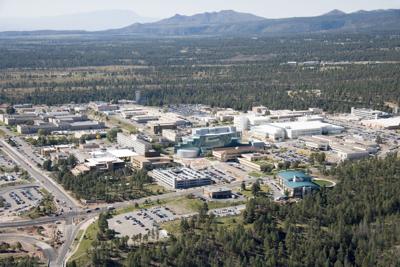Los Alamos National Laboratory in New Mexico could end up producing 80 plutonium pits – nuclear weapon cores – per year, if the National Nuclear Security Administration's hand is forced, according to a forward-looking environmental study published this week.
New pit-related equipment and other upgrades to be installed at PF-4, a Los Alamos plutonium facility, would both "provide the ability to produce a minimum of 30 pits per year" and make possible "surge efforts to produce 80 pits per year" to meet national demands, the study, a draft supplement analysis of environmental impact, states.
Federal law requires the production of 80 plutonium pits – the triggers at the heart of modern nuclear weapons – by 2030. The 2018 Nuclear Posture Review, an updated Pentagon policy document ordered by President Donald Trump, further reinforced the need for an 80-pits-per-year capability.
The U.S. has not had for years a significant ability to make the nuclear weapon cores. The last place pits were produced en masse, the Rocky Flats Plant in Colorado, was raided by the FBI decades ago and was subsequently shuttered.
In May 2018, the Department of Energy's National Nuclear Security Administration and the Department of Defense together recommended making pits at two places: the Savannah River Site, south of Aiken, and Los Alamos, a storied plutonium center of excellence near Albuquerque and Santa Fe.
The Savannah River Site would pump out a majority of the pits, 50, by 2030, whereas Los Alamos would produce the remainder, 30, they counseled. A tandem, cross-country approach is more flexible, officials say, and prevents a single failure from crippling the entire endeavor.
Critics and doubters, though, certainly do exist.
Should something not work out at the Savannah River Site – an entirely new facility, the proposed Savannah River Plutonium Processing Facility, needs to be designed and built with the bones of the multibillion-dollar Mixed Oxide Fuel Fabrication Facility, among other things – Los Alamos would, seemingly, span the production gap.
The NNSA already operates at the 310-square-mile Savannah River Site, near the South Carolina and Georgia border, and sports a palmy footprint there. The weapons-and-nonproliferation agency formally canceled the flagging MOX project in October 2018.
Hitting the 30-pits-per-year mark at Los Alamos, according to the NNSA's new environmental review, would require hundreds more people. "Reassignments" would be required for any production surges, the study states, and the need for more workers would need evaluating.
"It is assumed that actions for 30 pits per year are completed prior to developing the ability to implement a short-term surge capacity," reads the National Nuclear Security Administration's draft supplement analysis, a lengthy work that some nuclear watchers have denounced.
"This document contradicts statements that the laboratory and the NNSA have been saying for the last six months," Greg Mello with Los Alamos Study Group said Thursday.
"The upshot is that NNSA is building an 80 pits per year pit production capability at LANL right now," Mello said separately.




